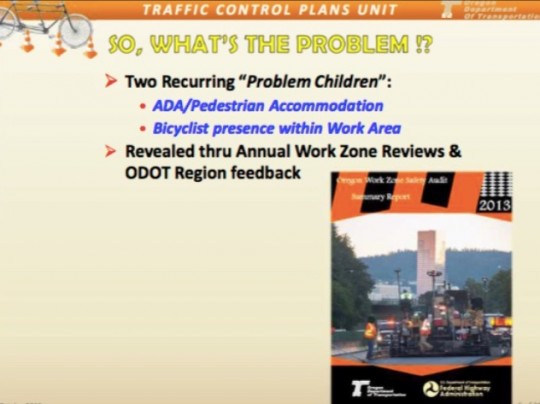
For years now transportation advocates have been battling the tides of the Oregon Department of Transportation. It’s an agency — like all state highway agencies — that was born and raised in the automobile era yet now operates in an era where many people want to walk and bike and use our roads without a car. While there have been glimmers of reform, recent decisions have made it clear that the real changes many of us hope for are still a ways off.
Last night while I was doing research for upcoming stories on ODOT’s glaring safety gap on Lombard at 42nd where Martin Greenough was killed 17 days ago, I came across something that speaks to the urgent need to reform our transportation department.
This year ODOT’s Traffic Safety division hosted a conference and they posted all the presentations online. I noted a Bike/Ped section so I clicked a link titled, “WZ Bike Ped ADA Accommodation” without knowing what to expect. I soon realized “WZ” stood for work zone. The presentation was about how to manage access for walkers, bikers, and ADA accomodations during construction projects.
Advertisement
It was an interesting presentation. Then I came to a slide titled, “So, what’s the problem!?”. According to ODOT’s Traffic Control Plans Unit (who wrote the presentation), there are two “recurring problem children”: “ADA/pedestrian accomodation” and “Bicyclist presence with Work Area.”
The rest of the slides offered examples of how to build safe access for biking, walking and wheelchair/scooter use in work zones. There were tips on using “Pedestrian Channelizing Devices” (PCDs for short) and correct signage to use when a bikeway is blocked. All very important information.
But I kept coming back to the “problem children” thing. So I tweeted a picture of the slide.
Turns out someone at ODOT saw that tweet because today when I went to view the presentation again it was gone. The link now points to an error page.
I’ve asked someone at the Traffic Safety Division why the presentation was taken down but I haven’t heard back.
I’m concerned that ODOT staff chose to frame this very important safety issue by using the phrase “problem children” to refer to the need to accomodate users of our roadways who are not in cars. It’s insensitive. And more importantly, it offers yet another window into an agency with an organizational culture that is out-of-touch with what Oregonians want and deserve.
UPDATE at 3:12 pm: I just heard back from Shelley Snow in ODOT’s Public Affairs office. She apologized for the wording of the slide and says the Traffic Plans Unit staffers are working to revise it. Her’s the email Snow sent us:
“Jonathan, thanks for writing in – literally, we were just about to write you regarding the slide you found online when I got your email. We at ODOT want to apologize for the wording that refers to bicyclists, pedestrians and people with disabilities as “problem children.” We agree that it is an inappropriate way to describe this group of travelers and we want to emphasize that this is not at all how ODOT or any of our employees feel about bicyclists, pedestrians, people with disabilities or any other users of the transportation system. It was a mistake to use this phrase to describe the areas in which we have actually been working extra hard to improve safety.
I talked to Scott McCanna, one of our work zone engineers, and he said it was never the intention to demean anyone with the description, especially because he knows first-hand how important it is for him personally, and his colleagues as safety engineers, to be especially protective of the transportation system’s most vulnerable users. He told me that — “ODOT has made significant advances in our design and construction processes toward safely accommodating bicycles and pedestrians in work zones. We’ve introduced new standards, new products, and new procedures to make passage through and/or around active work zones safer for users of other modes of travel besides motor vehicle.” He said the slide show as a whole shows some of these efforts, but we took the page with all of the conference materials offline and we’ve asked Scott and his team to review the slide show and make appropriate changes.”
UPDATE, 3:49 pm: Here’s the newly revised slide and the link to the full presentation PDF (11MB):
— Jonathan Maus, (503) 706-8804 – jonathan@bikeportland.org


